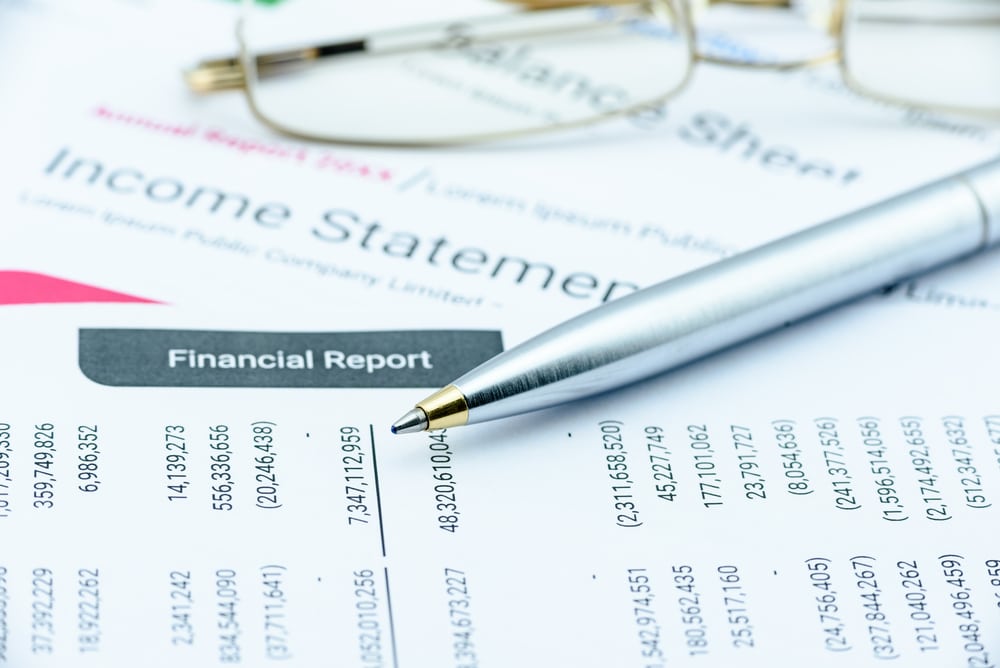There are several financial statements produced by businesses to indicate their financial health: the income statement, balance sheet, and cash flow statement. A cash flow statement reflects the actual amount of cash a business has on hand, helping to assess the liquidity of a business. While both income statements and balance sheets involve detailing revenue, they do so in different ways and for different purposes.
This article outlines the key differences between the two. We’ll begin by defining each document.
What is an Income Statement?
An income statement is used to report a business’s income and expenses over a specific period of time. Also known as a profit and loss (P&L) statement, this document follows a standardized format to disclose total income or gross profit.
The goal of an income statement is to demonstrate profitability, and are often used to compare profitability between various reporting periods, be it monthly, quarterly, or annually.
What is a Balance Sheet?
A balance sheet details a company’s assets, liabilities, and owners’ or shareholders’ equity, and is used to show how a business is managing its resources. It is called a “balance sheet” because it includes two sides (i.e. sets of data) that should balance out to the same figures. The liabilities and shareholder equity should add up to equal the assets on one side, while on the other side, the difference between assets and liabilities should equal the shareholder equity.
Balance sheets provide a detailed accounting of every asset and liability a company has, showing how each relates to shareholder equity and demonstrating the effectiveness of the company’s resource management.
Income Statement vs. Balance Sheet: Key Differences
While both documents are essential for businesses, income statements and balance sheets differ in terms of their purpose and the information they present. The following table outlines the basic differences:
| Income Statement | Balance Sheet |
| Shows profitability over a period of time | Shows the value of a company at a specific date |
| Includes revenue and expenses | Includes assets, liabilities, and shareholder equity |
| Used to track the ratio of income vs. expenses and secure financing | Used to determine shareholder equity value and track liquidity for paying off debts |
Purpose and Use
Income Statement
An income statement is commonly prepared on an annual basis to show profitability over the calendar year. It can be used internally for accounting purposes, such as analyzing how much revenue is allocated toward expenses, but is also required when applying for business loans or other financing.
Balance Sheet
A balance sheet outlines the relationship between assets, liabilities, and shareholders’ (or owners’) equity. Because it uses these figures to show the value of a company, the balance sheet is useful for attracting talent, securing financing, and presenting risks to shareholders. For example, if your assets are significantly greater than your liabilities, shareholders’ equity will have a higher value.
Components
The components of a balance sheet vs. those of an income statement is a key differentiator between the two documents. Whereas an income statement provides a broader perspective of business performance, balance sheets include a detailed view of the amount of value and risk of the business.
Income Statement
An income statement focuses on profits and losses, outlining all income and expenses over the reporting period, including:
- Net sales: How much money was made in sales of products or services
- Cost of goods sold (COGS): How much it costs to generate the products or services
- Operating expenses: Costs related to sales, marketing, and administration
Balance Sheet
A balance sheet outlines assets, liabilities, and shareholder equity. Current Assets will convert to cash within a year and include:
- Cash (money in the bank)
- Cash equivalents (short-term investments)
- Prepaid expenses (rent, insurance, or other expenses that are paid in advance)
- Inventory (products that have been generated but not sold)
- Accounts receivable (i.e. unpaid invoices and sale transactions)
- Marketable securities (stocks, bonds, and other assets that can be sold on a public market)
Noncurrent assets will not convert to cash within a year, but still add value to the company. These include:
- Land the company owns
- Patents, trademarks, or brands the company owns
- Goodwill (when one company purchases another for more than it’s worth)
- Intellectual property (unique ideas that are legally protected by the company)
- Equipment used to produce goods or perform services
Similarly, liabilities are both current (payroll, rent, utilities, etc.) and noncurrent (leases, loans, bonds payable, etc.). Shareholder equity includes both money a shareholder has contributed, and earnings separate from these contributions.
Results
The end result after filling out an income statement is the business’s net income or profit margin. This is the difference between income and expenses, demonstrating how spending compares with earnings over the set time period. Whatever is left after subtracting expenses from income is the business’s profit for that period.
A balance sheet will have two resulting figures, one for each side of the statement. If the balance sheet is accurate, these figures will match, balancing out so that the assets, liabilities, and shareholder equity match up. If these figures balance, then the balance sheet accurately reflects how assets and liabilities relate to shareholder equity. If the figures don’t balance, then the data and calculations need to be checked for accuracy and corrected.
Bottom Line: How is the Income Statement Related to the Balance Sheet?
Both income statements and balance sheets are used to demonstrate the financial health of your company, but do so through different methods. Both can help you evaluate losses and risks, enabling you to adjust spending to decrease liabilities.
An effective business budget is produced when based on financial statements is included in budgeting process, including income statements and balance sheets. Both documents can help identify wasted resources and faciliate cost-cutting measures, which can improve efficiency and boost your bottom line.
Financial reporting is an essential part of running a business, but it can be overwhelming and time-intensive. And that’s one of the main challenges addressed by Lili’s Accounting Software, which automatically generates financial reports based on your transaction categorization, including income statements, cash flow statements, and expense reports. Make it easier to get organized and balance your books with Lili!




